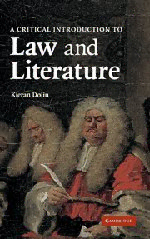
A Critical Introduction to Law and Literature PDF
Preview A Critical Introduction to Law and Literature
This page intentionally left blank A CRITICAL INTRODUCTION TO LAW AND LITERATURE Despitetheirapparentseparation,lawandliteraturehavebeenclosely linkedfieldsthroughouthistory.Linguisticcreativityiscentraltothe law,with literarymodes suchasnarrativeandmetaphorinfiltrating legaltexts.Equally,legalnormsofgoodandbadconduct,ofidentity and human responsibility, are reflected or subverted in literature’s engagementwithquestionsoflawandjustice.Lawseekstoregulate creativeexpression,whileliterarytextscritiqueandsometimesopenly resist the law. Kieran Dolin introduces this interdisciplinary field, focusingonthemanywaysthatlawandliteraturehaveaddressedand engagedwitheachother.Hechartsthehistoryoftheshiftingrelations betweenthetwodisciplines,fromtheopenaffiliationbetweenliter- atureandlawinthesixteenth-centuryInnsofCourttothelessvisible linksofcontemporaryculture.Eachchapterisorganizedaroundclose analysisofafamoustrialorliterary-legalencounter.Thewidereson- anceofsuchtrialsilluminatestheculturalcentrality oflaw,andthe social responsiveness of literature. This book provides an accessible guidetooneofthemostexcitingareasofinterdisciplinaryscholarship today. KIERAN DOLIN is Senior Lecturer in English and Cultural Studies attheUniversityofWesternAustralia.HeistheauthorofFictionand the Law: Legal Discourse in Victorian and Modernist Literature (Cambridge,1999). A CRITICAL INTRODUCTION TO LAW AND LITERATURE KIERAN DOLIN CAMBRIDGEUNIVERSITYPRESS Cambridge, New York, Melbourne, Madrid, Cape Town, Singapore, São Paulo Cambridge University Press TheEdinburghBuilding,CambridgeCB28RU,UK Published in the United States of America by Cambridge University Press, New York www.cambridge.org Information on this title: www.cambridge.org/9780521807432 ©KieranDolin2007 Thispublicationisincopyright.Subjecttostatutoryexceptionandtotheprovisionof relevantcollectivelicensingagreements,noreproductionofanypartmaytakeplace withoutthewrittenpermissionofCambridgeUniversityPress. Firstpublishedinprintformat 2007 ISBN-13 978-0-511-27503-6 eBook (NetLibrary) ISBN-10 0-511-27503-X eBook (NetLibrary) ISBN-13 978-0-521-80743-2 hardback ISBN-10 0-521-80743-3 hardback CambridgeUniversityPresshasnoresponsibilityforthepersistenceoraccuracyofurls forexternalorthird-partyinternetwebsitesreferredtointhispublication,anddoesnot guaranteethatanycontentonsuchwebsitesis,orwillremain,accurateorappropriate. Contents Preface pagevii Introductiontolawandliterature:walkingtheboundary withRobertFrostandtheSupremeCourt 1 PART I EMINENT DOMAINS: THE TEXT OF THE LAW 17 AND THE LAW OF THE TEXT 1 Law’slanguage 19 2 Literatureunderthelaw 41 73 PART II LAW AND LITERATURE IN HISTORY 3 Renaissancehumanismandthenewcultureofcontract 75 4 Crimeandpunishmentintheeighteenthcentury 96 5 ThewomanquestioninVictorianEngland 120 6 Thecommonlawandtheacheofmodernism 143 7 RumpoleinAfrica:lawandliteratureinpost-colonialsociety 166 8 RaceandrepresentationincontemporaryAmerica 182 Conclusion 207 Notes 213 Bibliography 235 Index 260 v Preface ‘Poetry,likethelaw,isafiction’,wroteWilliamHazlittinacriticalessayof 1816.Hazlittthecritictookashissubjectallaspectsofhissociety’sculture, includingtheconnectionsbetweenlaw,literatureandpower.Heanalysed therhetoricofthelawyersandthelegislativeactsofpoliticiansasproducts of a legal imagination comparable with the literary imagination of the poets. He examined the effects of those imaginings on the people, who were subjects of the law as well as readers of literary fictions. With characteristic forthrightness, he appended an aesthetic judgment to the comparison:‘Poetry,likethelaw,isafiction;onlyamoreagreeableone.’ This book shares the conviction that law and literature have common propertiesoflanguageandvision.InitItrytoshowhowthisconnection matters, how it works to shape a culture’s notions of justice and legal entitlement.Thefirstthreechaptersexplorethebasesforlinkinglawand literature;thenextsixpresentahistoricalaccountofshiftsintheirrelation- shipinAnglophoneculturefromtheRenaissancetothepresent. In undertaking this study I have had the benefit of advice and support from many colleagues at the University of Western Australia. I would particularly like to thank Daniel Brown, Victoria Burrows, Tanya Dalziell, Gareth Griffiths, Tony Hughes-d’Aeth, Judith Johnston, Gail Jones,AndrewLynch,IanSaunders,BobWhiteandChrisWortham.For administrative support I am grateful to Sue Lewis and Linda Cresswell. I wouldalsoliketoacknowledgethepleasureandprofitIhavederivedfrom conversationswithMichaelMeehan,PenelopePether,SimonPetch,Peter Rush, Richard Weisberg and other Law and Literature scholars. Over manyyearsHilaryFraserandRichardFreadmanhaveprovidedinspiration aswellasguidance.MybrotherTimDolinhasgenerouslysharedhisgreat critical acuity. However, the author accepts liability for any mistakes herein. It is a pleasure to acknowledge the financial support of an Australian Research Council Discovery Grant, which funded time to write, research vii viii Preface assistance and travel to archives. My research assistants, Victoria Bladen, Duc Dau and Catherine Johns, found an abundance of material and offered accurate summaries and fruitful suggestions. I would also like to thankmyownuniversityfortheawardofUWAResearchGrantsenabling me to concentrate on this study through teaching relief. I have drawn heavily on the resources of the Scholars’ Centre in the UWA Library and wouldliketoexpressmyappreciationtoDrTobyBurrows,theDirector, andthestaffthere,fortheirefficiencyandexperthelp.Iwishtothankthe staffoftheBodleianLibrary,Oxford,forassistingmetomakeuseoftheir unrivalledcollection. I amdeeply gratefulto Cambridge University Press: to my editor, Ray Ryan,forsupportingthisprojectfromitsinception,andforhisencourage- ment and advice. I would also like to thank the assistant editor Maartje Scheltens, and the readers of both the original proposal and the manu- script,whosesuggestionswereextremelyhelpful.Forpermissiontorepro- duce the image on the cover, Hogarth’s The Bench, I am grateful to the Syndics of the Fitzwilliam Museum, Cambridge. The following material is reproduced by permission of the copyright holder: ‘Mending Wall’fromThePoetryofRobertFrost,editedbyEdwardConneryLatham #1969.ReprintedbypermissionofHenryHoltandcompany,LLC. My greatest debt is to my wife, Jane Courtney, for her love and good counsel, and to our children, Patrick, Michael and Anna. Their love of words and stories, their questioning of law (and literature) have been an indispensablecounterpointtothewritingofthisbook.
